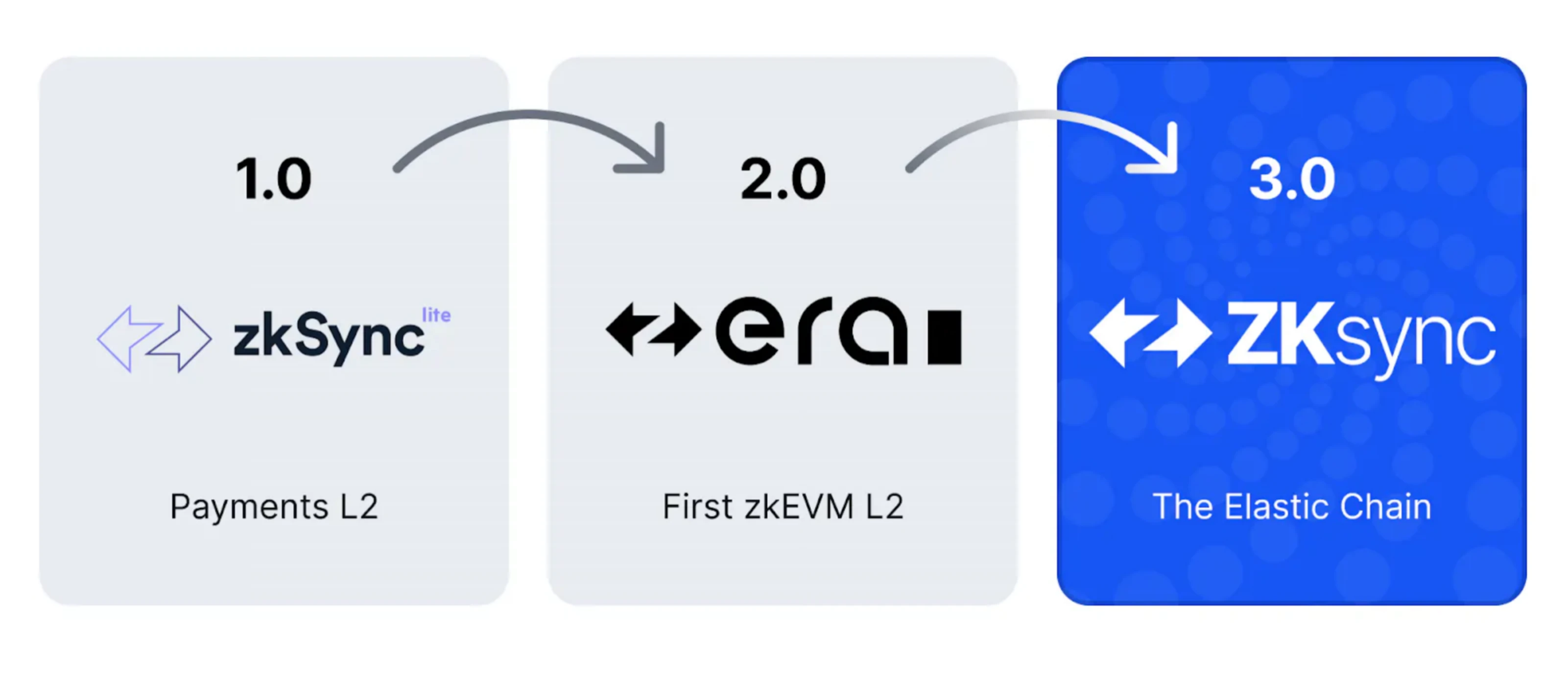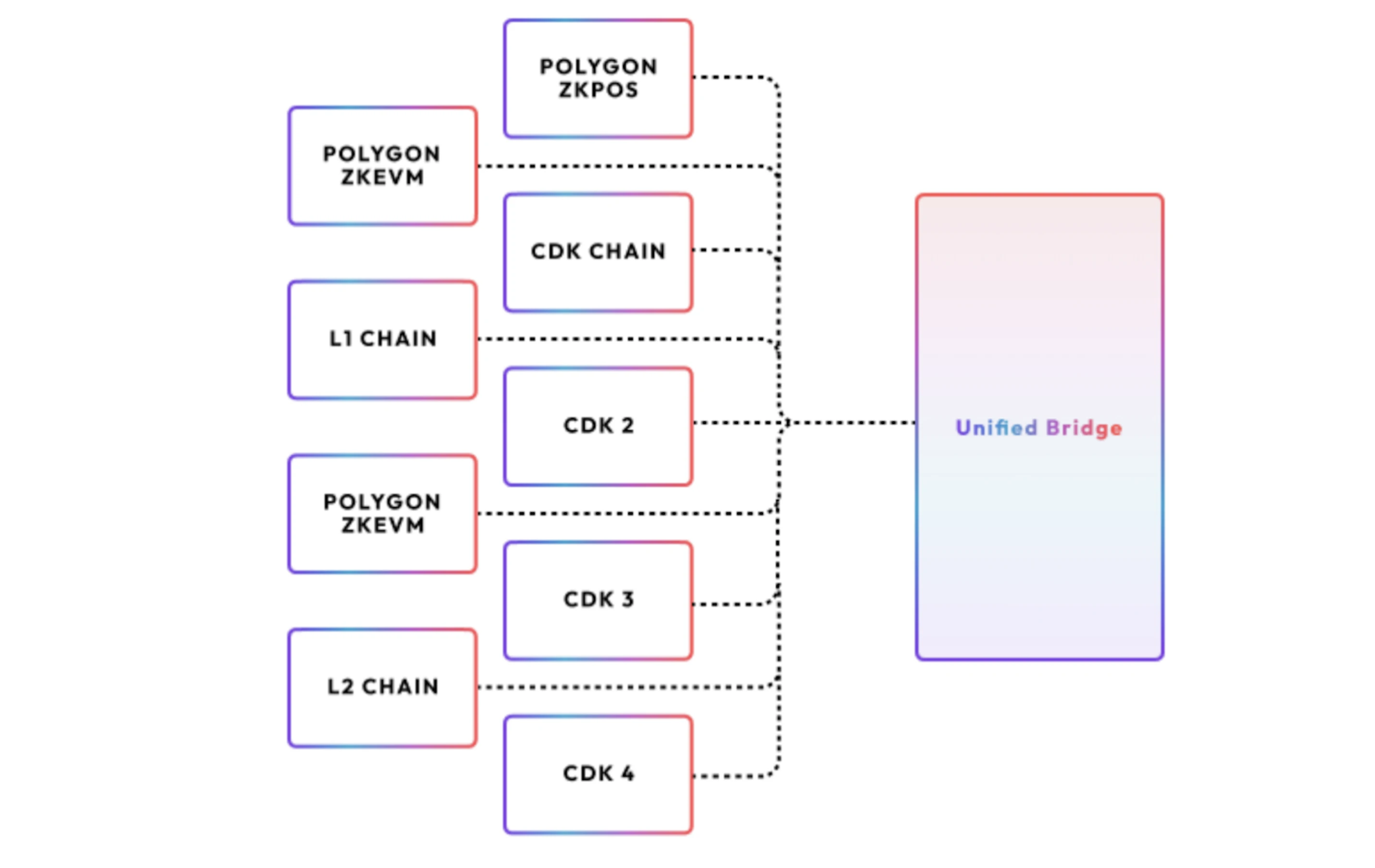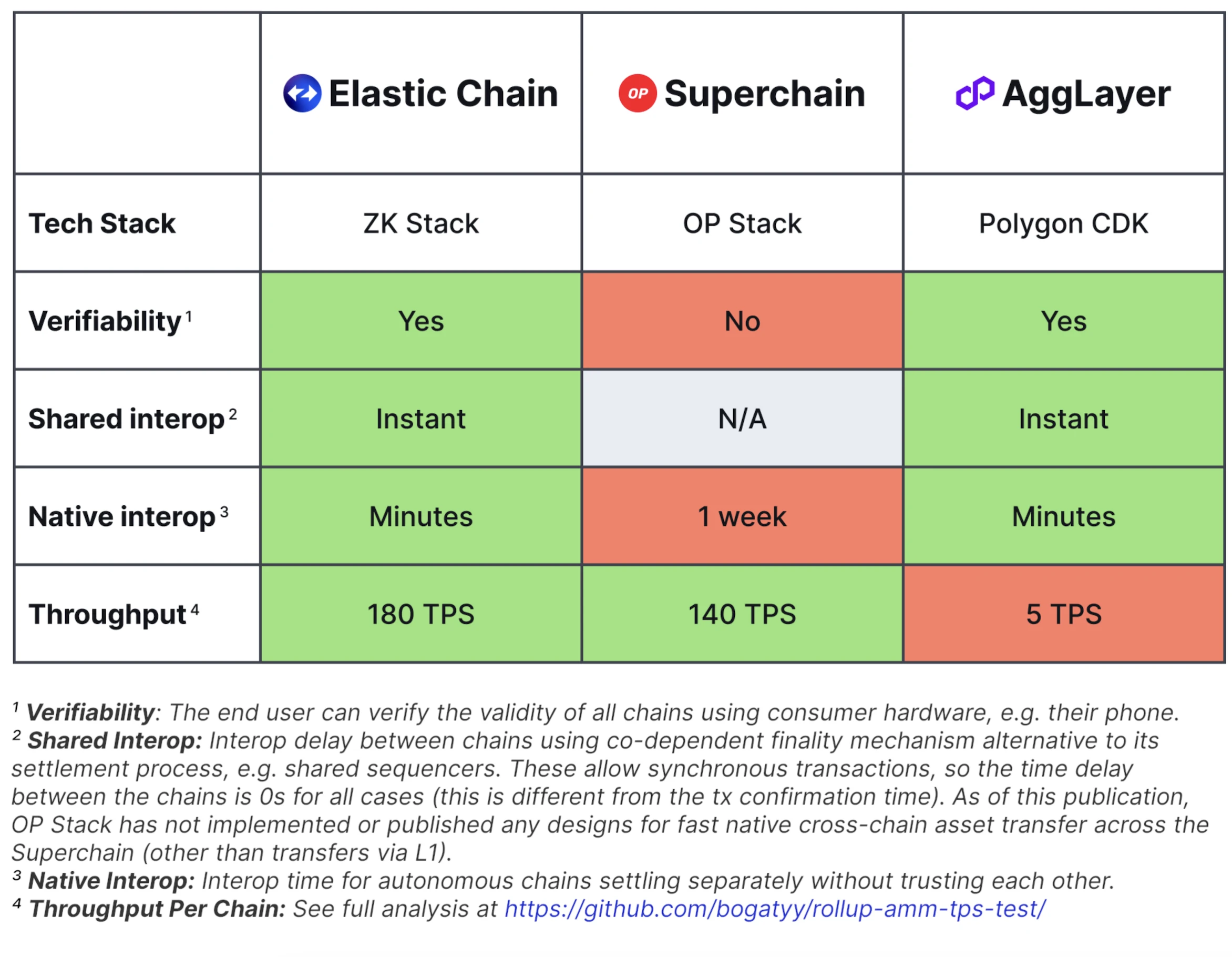原文作者:YBB资本研究员Ac-Core

结论
-
Cross-chain asset transfers vary due to the different architectures and consensus mechanisms of different blockchains, and lack of unified standards, leading to a complex and expensive verification process that restricts asset mobility. Existing third-party bridges face trust and security challenges, and centralized bridges need to maintain liquidity and pass on costs to users. One-click chain issuance is like solving the triangle problem and is a compromise asset bridging solution.
-
Market maturity: OP Stack and Superchain were the first to seize the market, and Base has become a successful representative; AggLayer is more easily accepted due to its native compatibility with Ethereum, but the security and reliability of the aggregation process must be ensured; Elastic Chain needs to judge the development of ZKsSync itself. Whether in terms of market or technology, OP is still the preferred choice in the short term, and ZK is the preferred choice in the long term.
-
In the context of insufficient industry innovation, DeFi is still the main application of Rollup. At this stage, the probability of DePIN, RWA, and large-scale GameFi appearing in Rollup is not high. SocialFi and NFT markets will appear in Rollup, but the market heat is unknown. The Matthew effect is generally suitable for blockchain. The trend of unlimited issuance of Rollup focuses on the head in the long term and the middle and lower reaches in the short term.
1. Connecting islands between chains: the bridge problem
When we transfer assets across chains, different blockchains each have unique architectures, consensus mechanisms, state proofs, and state transitions, and the lack of unified standards and interoperability leads to certain complexities in cross-chain communication and data exchange. These verification processes are usually too expensive to be performed on-chain. This limitation has led to a surge in certification networks that use multi-signature committees to prove the state of each others chains. Therefore, there is currently no universal decentralized standard or protocol that can achieve interoperability between all blockchains, which limits the free flow of assets between different blockchains.
In order to facilitate cross-chain asset transfers, a large number of third-party bridges have emerged, but these bridges face huge network security challenges in terms of trust issues in operation. Even if centralized bridges can fully ensure security, they still need to maintain sufficient liquidity on each integrated chain to maintain operations, and the cost will be passed on to users. Currently, there are problems that cannot meet the requirements of native decentralized asset bridging and it is difficult to trust third-party bridges. ZKsync, Polygon, and Optimism have respectively launched their own more native localized multi-chain expansion solutions of Elastic Chain, AggLayer, and Superchain Explainer.
2. ZKsync 3.0: Elastic Chain

Image source: zksync.mirror
In 2023, Matter Labs, the main development company behind ZKsync, released their ZK Stack, a toolkit that allows developers to build their own blockchains based on ZKsync technology. Essentially, these custom chains will be connected to each other through the Elastic Chain, turning ZKsync 3.0 from a single Ethereum L2 into The Elastic Chain.
The core upgrade of the ZKsync 3.0 protocol was released on June 7, 2024. It is the most complex upgrade of ZKsync at this stage. It reconfigures the ZKsync L1 bridge into a shared router contract to support the growing interoperable ZK chain network and local, trustless, low-cost interoperability between chains supported by the ZK Rollup framework ZK Stack.
According to Matter Labs: Elastic Chain is an infinitely scalable network of ZK Chains (rollups, validiums, and volitions) that are secured by mathematical verification methods and interoperate seamlessly under a unified and intuitive user experience, aiming to make interoperability between users in different ZKsync ecosystems smoother and more fluid.
2.1 Elastic Chain Architecture
Elastic Chain is not implemented solely by ZK technology, nor can it be implemented by adding a ZK-proof patch to other non-ZK multi-chain systems. From a high-level perspective, its network is implemented by three parts: ZK Router, ZK Gateway, and ZK Chains.
1.ZK Router
-
Core routing mechanism: ZK Router is the main routing component of the ZKSync 3.0 architecture, responsible for managing and coordinating communication and data transmission between different chains and nodes in the network;
-
Cross-chain communication: Through efficient cross-chain communication protocols, ZK Router ensures that data between different chains can be transmitted quickly and securely, improving the interoperability and performance of the overall network.
2.ZK Gateway (ZK Gateway/Entrance and Exit):
-
Entry and exit nodes: ZK Gateway acts as the entry and exit nodes of the ZKSync 3.0 network, handling the interaction between external blockchains (such as the Ethereum main chain) and the ZKSync network;
-
Asset bridging: responsible for bridging and transferring assets between external blockchains and the ZKSync network, ensuring that assets can flow between different chains safely and efficiently;
-
Transaction aggregation: Aggregate users’ transactions into batches, generate zero-knowledge proofs, and submit them to external blockchains for verification, reducing on-chain data load and transaction fees;
-
Middleware: The whole can be understood as the middleware deployed between Ethereum and ZK Chains to promote full interoperability between ZK Chains.
3. ZK Chains (ZK chain itself):
The validity and security of the transaction is ensured by generating and verifying zero-knowledge proofs, and the results are submitted to ZK Router for aggregation and coordination. They are interconnected through ZK Gateway and L1 smart contracts, and are fully independent, customizable autonomous Rollup, Validium or Volitions built using ZK Stack.
According to ZKsync, Gateway is a key component of Elastic Chain to achieve seamless settlement of ZK Chains to Ethereum. Submitting proofs and data to Ethereum through Gateway has the following advantages:
-
Cross-batch and cross-chain proof synthesis to reduce L1 verification costs;
-
State difference compression compresses small batches of data sent to the Gateway and efficiently forwards them to L1 in large batches;
-
Faster final confirmation enables low-latency cross-chain bridging by verifying the chains proofs and preventing their contradictions, which is strengthened by the staking of a large number of validators. ZK Chain does not need to trust other chains;
-
Activity: The activity of each ZK Chain is managed independently by its validator. The Gateway does not affect its activity, and the chain can leave the Gateway freely.
-
Censorship-resistant cross-chain mandatory transactions will be cheaper than normal L1 censorship-resistant transactions, making them more accessible to all users.
ZK Chains can settle directly to Ethereum without using ZK Gateway and can choose to leave the ZK Gateway network at any time without affecting the security of their chain. ZK Chains can switch freely between using ZK Gateway and settling directly to Ethereum. ZK Gateway will be operated by a decentralized, trustless cluster of validators to ensure the resilience and reliability of the network. ERC 20 tokens are required to participate in this decentralized verification process. ZKSync network governance will designate a token for this purpose (which can be a ZK token).
Validators will be charged a bridge fee as well as a fee for each byte of state difference data published to ZK Gateway. This provides an incentive for validators to join ZK Gateway, as their income can grow exponentially as more and more value transactions are put on the chain. At the same time, due to the recompression service provided by validators, settling data through ZK Gateway will be cheaper than settling directly on the Ethereum network, which may be the reason why most ZK Chains may choose to join.
3. Polygon 2.0: Agglayer

Image source: Polygon Agglayer
3.1 Agglayer Design Origin
Similar to OP Stack and ZK Stack, blockchains created using Polygon CDK can be directly connected to Agglayer, leveraging its unified bridging and security services to achieve interoperability with other blockchains, which together constitute the core architecture of Polygon 2.0.
The core idea of Agglayer is derived from the Shared Validity Sequencing design proposed by Umbra Research, which aims to achieve atomic cross-chain interoperability between multiple Optimistic Rollups. Through the shared sorter, the system can uniformly handle the transaction ordering and state root publishing of multiple Rollups, ensuring atomicity and conditional execution.
Implementation logic: The following three components are required:
-
Shared sorter: receives and processes cross-chain transaction requests;
-
Block construction algorithm: The shared sorter is responsible for building blocks containing cross-chain operations and ensuring the atomicity of these operations;
-
Shared Fraud Proofs: Share fraud proof mechanisms between related Rollups to enforce cross-chain operations.
Since the existing Rollup already has the function of two-way messaging between Layer 1 and Layer 2, Umbra only added a MintBurnSystemContract contract (Burn and Mint) to complete the three components.
工作流程:
-
Burn operation on chain A: Any contract or external account can call it, and it will be recorded in burnTree after success;
-
Mint operation on chain B: The sorter records it to mintTree after successful execution.
Invariants and consistency:
Consistency of Merkle roots: The Merkle roots of burnTree on chain A and mintTree on chain B must be equal to ensure consistency and atomicity of cross-chain operations.
system running:
The shared sorter is responsible for publishing the transaction batches and declared state roots of both Rollups to Ethereum. It can be centralized or decentralized (such as Metis). The sorter receives transactions and builds blocks for Rollup A and B. For a transaction on A, if the interaction with MintBurnSystemContract is successful, it attempts to execute the corresponding Mint transaction on B. If the Mint transaction succeeds, the Burn transaction on A and the Mint transaction on B are included; if it fails, these two transactions are excluded.
3.2 Agglayer Core Components
In Polygon 2.0s Agglayer, Unified Bridge and Pessimistic Proofs are its core components.
1. Unified Bridge
Technical framework:
-
Cross-chain communication: The core of the unified bridge is to achieve seamless communication between different chains. It uses a cross-chain communication protocol to achieve data and asset transfer between different Layer 2 solutions and the Ethereum main chain.
-
Liquidity Aggregation: The bridge aggregates liquidity from different Layer 2 solutions, allowing users to move assets freely between different chains without worrying about liquidity fragmentation.
Implementation logic:
-
Message passing: Unified Bridge implements cross-chain communication through a message passing mechanism. Messages contain transaction-related information and are passed between chains through the bridge protocol;
-
Asset locking and releasing: When a user locks an asset on one chain, the unified bridge will release the equivalent asset on the target chain accordingly. This process requires the use of smart contracts to ensure security and transparency;
-
Interoperability protocols: To ensure interoperability between different chains, the Unified Bridge uses standardized interoperability protocols. These protocols define how to process cross-chain transactions, how to verify the validity of transactions, and how to handle potential conflicts.

Image source: Aggregated Blockchains: A New Thesis
2. Pessimistic Proofs
Technical framework:
-
Security: Pessimistic proof is a security measure designed to prevent fraudulent transactions. It ensures that all transactions are valid by introducing an additional verification step in the transaction verification process;
-
Delayed Verification: Unlike Optimistic Proofs, Pessimistic Proofs assume that the transaction may be malicious and perform a full verification before confirmation.
Implementation logic:
-
Initial verification: After the transaction is submitted, the system will immediately perform preliminary verification. This includes checking the basic information of the transaction and the validity of the signature;
-
Deep Verification: After the initial verification is passed, the transaction will enter the deep verification stage. The system will call a series of smart contracts to check the complexity and potential risks of the transaction;
-
Dispute Resolution: If any issues are found during the verification process, the system will trigger a dispute resolution mechanism, which allows users and validators to submit additional proofs to resolve disputes and ensure the final validity of transactions.
Through the unified bridge and pessimistic proof, Agglayer is able to provide a highly secure, scalable and interoperable blockchain environment. These components not only enhance the security of the system, but also simplify the operation of cross-chain transactions, making it easier for users to interact between different chains. For more information, please see YBB Capitals previous article From Modularity to Aggregation, Exploring the Agglayer Core of Polygon 2.0 (1)
4. Optimism: Superchain Explainer
Optimism took the lead in launching a one-click chain in 2023, and the first task was to establish a unified network standard for OP Stack. OP Stack is the launch platform of the Ethereum expansion solution, The Optimism Superchain, and is also the hub for all L2s built using OP stack to interact and trade.
I believe everyone is already familiar with the OP Stack. To make a brief introduction, the Optimism Superchain will share a common OP Stack development stack, bridge, communication layer, and security to ensure that each chain can communicate in a coordinated manner and function as a single unit. The structure can be broken down into five different layers, each with its own specific purpose and function:
-
The data availability layer determines that the original input of the chain based on the OP stack is mainly obtained through the Ethereum DA;
-
The sorting layer controls how user transactions are collected and forwarded, and is usually managed by a single sequencer;
-
The derivative layer processes the raw data into the input of the execution layer, mainly using Rollup;
-
The execution layer defines the system state structure and transition functions. The Ethereum Virtual Machine (EVM) is the central module;
-
The settlement layer allows external blockchains to view the valid state of the OP Stack chain through proof-of-failure based proofs.
Compared with Elastic Chain and Agglayer, Optimism Superchain appeared the earliest and occupied the market first. It also outperformed Base and accounted for the vast majority of daily Gas expenditures, which directly reflects the on-chain activity of Base.

Image source: Dune Optimism – Superchain Onchain Data
5. Subjective thoughts on one-click chain release (this chapter only represents the author’s personal opinion)
5.1 Competition between AggLayer, Superchain, and Elastic Chain
The above three expansion solutions are all extensions of their respective Rollup expansion narratives. From the perspective of market maturity, OP Stack and Superchain were the first to seize the market, and Base is already the most successful representative.
AggLayer has an advantage in native compatibility and can run directly on the existing Ethereum network without requiring major changes to the underlying protocol, making it more easily accepted by existing Ethereum users and developers. The advantage of this solution is that it can effectively utilize the existing Ethereum network. The challenge lies in how to ensure the security and reliability of the aggregation process.
The initial judgment of Elastic Chain at this stage is that it needs to judge the development of the ZKsync ecosystem and the construction of the community. If ZK sync itself does not develop, Elastic Chain may face resistance in attracting developers and maintaining the enthusiasm of the community in the future. Whether from the market or technical perspective, it is still better to look at OP in the short term and ZK in the long term.
In addition, the above three solutions will bring the original problem of Rollup: the degree of centralization is relatively concentrated. With the recent expansion plan of Based Rollup, it may also be a potential competitor in the future. It directly hands over the sorter to L1, that is, the way of Ethereum itself, so that L2 no longer needs additional sorters or complex verification steps. Although this more native expansion will also have some potential MEV problems, its subsequent development is still worth paying attention to.

Image source: ZKsync – Introducing the Elastic Chain
5.2 Rollup’s future development trends and application innovations
Overall, with the promotion of one-click chain launch, the number of Rollups, the mainstream expansion method of Ethereum, will continue to increase. Even with the explosion of the Bitcoin ecosystem in 2023, its non-native expansion also borrowed a lot of Ethereums expansion logic. In the context of insufficient market innovation, the application innovation and impact of Rollups may be limited.
For each VM chain, TVL is still the main indicator regardless of market changes, so the first applications to appear are still various DeFi protocols. In addition, SocialFi protocols and NFT trading markets may appear.
In other tracks, DePIN is difficult to develop on Rollup and L1, and the leader may appear in Solana; the RWA concept is more likely to develop on L1 but lacks confidence in Rollup; GameFi will also appear, but large games will only have opportunities on Rollup that focuses on GameFi. Therefore, the most certain application at this stage is still DeFi.
However, the Matthew effect of blockchain is obvious. With the advent of the multi-chain era, resources will be concentrated on leading projects, the strong will always be strong, and the bottom will be eliminated.
扩展链接:
(1) From modularization to aggregation: Exploring the Agglayer core of Polygon 2.0
参考文章:
【1】Introducing the Elastic Chain
https://zksync.mirror.xyz/BqdsMuLluf6AlWBgWOKoa587eQcFZq2 0 zTf 7 dYblxsU
【2】zkSync Protocol Upgrade v2 4: New precompiles, more blobs, Validiums, and more. #519
https://github.com/zkSync-Community-Hub/zksync-developers/discussions/519
This article is sourced from the internet: The Evolution of Ethereum: Unlimited Potential of Layer 2 Expansion and One-Click Multi-Chain
Related: Why can we still trust cryptocurrencies?
Original title: The Optimistic Crypto Pitch Original article by: Matti, Zee Prime Capital Original translation: 0x26 Editors Note: The development of cryptocurrency has entered deep waters. The importance of cultural and social attributes has been further enhanced. Technology can hardly become a real moat. New terms and narratives have received far more criticism than support. Faced with these sudden changes, many veteran players feel uncomfortable and even shout that cryptocurrencies are finished. But as community members said, firm belief is the only way out, which is why few people succeed. Mattis article The Optimistic Crypto Pitch explains why we can still believe in cryptocurrencies. The following is the full text of the article, compiled by Rhythm: Cryptocurrency has different definitions in the eyes of many people: some people think it…







